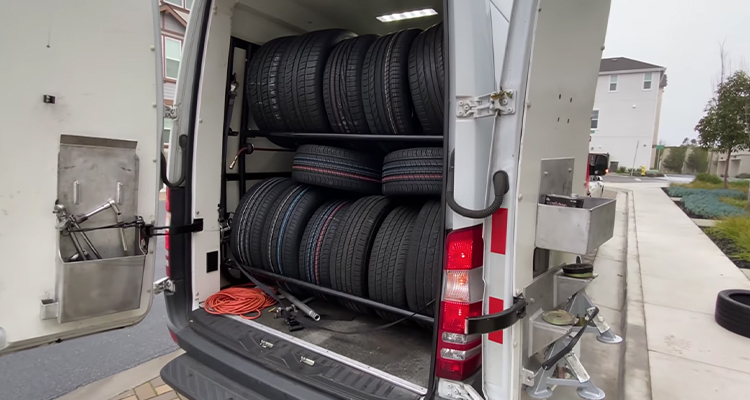Inexpensive Mobile Tire Replacement Las Vegas - Call Today!
Inexpensive Mobile Tire Replacement Las Vegas - Call Today!
Blog Article
Tire Solution: Proven Approaches for Ideal Tire Upkeep and Care
From ensuring proper tire stress to routine turning and positioning, there are tried and tested methods that can significantly extend the life-span of your tires and improve general driving experience. Let's delve right into the world of tire service and find the secrets to keeping your tires in top-notch shape for the lengthy haul - Mobile Tire Repair Las Vegas.
Importance of Tire Stress
Appropriate tire pressure advertises better fuel effectiveness, as under-inflated tires can lead to raised rolling resistance, creating the engine to work tougher and take in more gas. Proper tire pressure makes sure also tread wear, enhancing tire durability and saving money in the lengthy run by delaying the requirement for early replacements. Routinely readjusting and examining tire pressure, specifically in the past long journeys, is an easy yet efficient way to enhance vehicle efficiency, prolong tire lifespan, and focus on security on the road.
Tire Rotation Guidelines
When considering tire rotation guidelines, it is important to comprehend the importance of this maintenance job in optimizing tire lifespan and maintaining ideal lorry performance. Tire turning includes transforming the position of each tire on an automobile to make sure even step wear. Front tires often tend to use much more promptly than rear tires due to steering forces, making normal rotation crucial for balanced wear patterns. The recommended turning pattern varies relying on whether a car is front-wheel, rear-wheel, all-wheel, or four-wheel drive. Generally, tires need to be revolved every 5,000 to 7,500 miles, or as advised in the lorry guidebook. Ignoring tire turning can cause uneven wear, affecting handling, grip, and possibly compromising car safety. By adhering to appropriate rotation guidelines, vehicle drivers can prolong the life of their tires, improve gas efficiency, and enhance overall driving experience. Normal rotation is a simple yet efficient maintenance practice that contributes significantly to tire long life and automobile efficiency.

Benefits of Wheel Positioning
Guaranteeing correct wheel placement after tire rotation is essential for preserving balanced wear patterns and maximizing vehicle efficiency. Wheel alignment refers to the adjustment of the angles of the wheels to the maker's specifications. Among the vital benefits of wheel alignment is boosted dealing with and guiding feedback. When the wheels are correctly lined up, it lowers guiding effort, guaranteeing a smoother and much more regulated driving experience. Additionally, correct wheel positioning aids to extend the life expectancy of your tires. Misaligned wheels can cause uneven tire wear, leading to early tire substitute and boosted maintenance prices.

Tire Tread Depth Check
Executing a normal assessment of tire tread depth is essential for preserving risk-free more information driving conditions and extending the life expectancy of your tires. The step on your tires plays an essential function in providing grip, particularly in wet or slippery conditions. To check your tire tread deepness, you can utilize a tread depth gauge or the dime examination. The recommended tread depth goes to least 2/32 of an inch. It is time to change your tires this article to ensure optimum performance and security on the road if the step deepness is listed below this limit. Unequal walk wear can indicate problems with tire placement, suspension, or stress, highlighting the value of normal tread deepness checks. Ignoring to check and keep correct step depth can cause minimized grasp, longer braking ranges, and an enhanced danger of hydroplaning. By including tire step depth check out your regular maintenance schedule, you can drive with self-confidence recognizing that your tires remain in top problem.
Seasonal Tire Inspection
Seasonal tire examination is a basic aspect of tire maintenance that makes certain tires are prepared to encounter the challenges posed by various climate problems. In preparation for wintertime, it is important to check the tire pressure consistently as cool temperature levels can cause tire stress to drop. By conducting routine seasonal tire inspections, vehicle drivers can extend tire life expectancy, enhance fuel efficiency, and most notably, guarantee a protected driving experience in varying climate conditions.
Verdict
To conclude, preserving proper tire pressure, turning tires on a regular basis, straightening wheels correctly, checking step depth, and performing seasonal examinations are essential techniques for optimum tire treatment. go to my blog By complying with these shown methods, drivers can ensure their tires last longer, carry out far better, and add to total car safety and security. It is very important to focus on tire upkeep to avoid mishaps, enhance gas effectiveness, and lengthen the life expectancy of tires.
Ample tire stress advertises far better gas effectiveness, as under-inflated tires can lead to boosted rolling resistance, creating the engine to work more challenging and consume even more fuel.When considering tire rotation standards, it is vital to understand the significance of this upkeep task in taking full advantage of tire lifespan and preserving optimum automobile performance. Seasonal tire evaluation is a basic aspect of tire upkeep that ensures tires are prepared to deal with the obstacles presented by various weather conditions. By performing regular seasonal tire assessments, vehicle drivers can lengthen tire life-span, boost gas efficiency, and most significantly, guarantee a safe and secure driving experience in varying weather condition problems.
In final thought, preserving proper tire pressure, turning tires routinely, lining up wheels appropriately, monitoring walk depth, and conducting seasonal inspections are crucial practices for ideal tire care.
Report this page